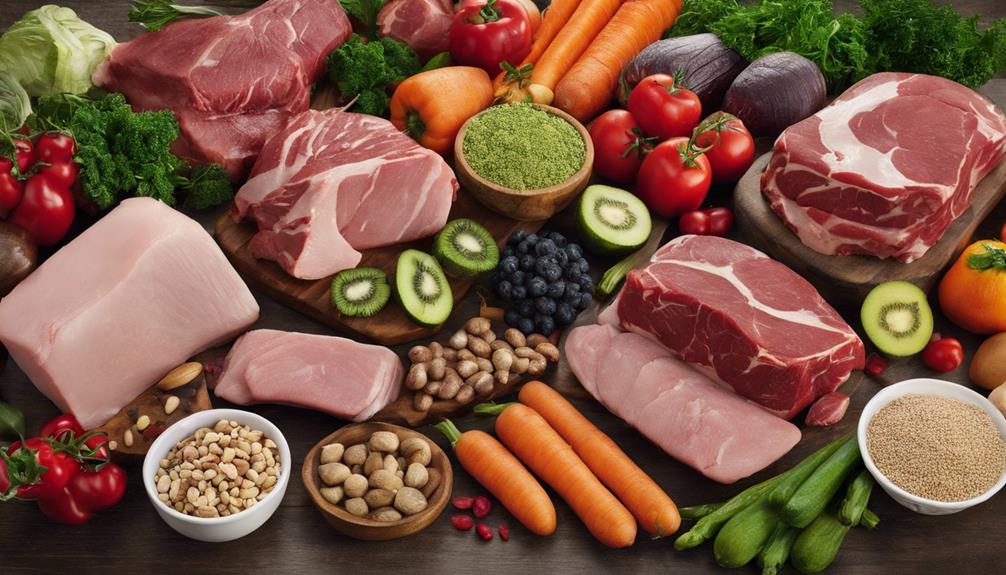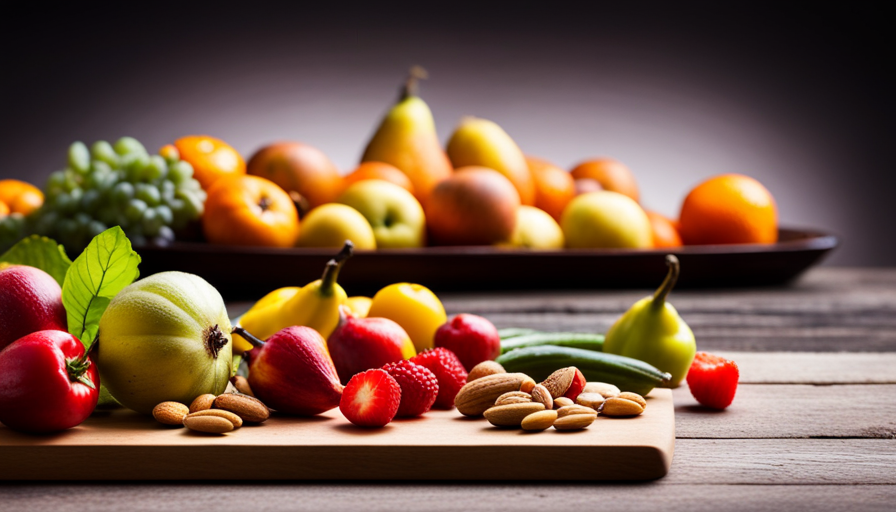Have you ever thought about how your body turns the food you eat into the energy it needs to operate? Let me tell you, the process is truly fascinating! It’s like a coordinated symphony of actions, all working together to extract essential nutrients from the food we ingest.
First, we start with ingestion, where we take in food through our mouth. Then comes the chewing, where our teeth and saliva break down the food into smaller pieces. Next, the tongue pushes the chewed food into the esophagus, which carries it to the stomach.
In the stomach, digestive enzymes and acids further break down the food. Then, in the small intestine, nutrients like carbohydrates, proteins, and fats are absorbed into the bloodstream. Feces are eliminated through the rectum and anus, while nutrients are transported to various cells and tissues via the bloodstream.
Finally, these raw materials are used by our cells for energy production, growth, and repair. Waste products, like carbon dioxide and urea, are eliminated through respiration and urine.
So, you see, the process of answer is a complex and remarkable journey that our body undertakes every time we eat. It’s a fine-tuned system that ensures we get the nourishment we need to thrive.
Key Takeaways
- The process of obtaining raw materials from food involves ingestion, digestion, absorption, and elimination.
- Chewing and saliva aid in the mechanical and chemical breakdown of food.
- The small intestine plays a crucial role in absorbing nutrients into the bloodstream for utilization by cells.
- Waste products, such as carbon dioxide and urea, are eliminated through respiration and urine respectively.
Ingestion: The process begins with the intake of food through the mouth.
To begin the process, I must first take in food through my mouth. This step is called ingestion. When I eat, food enters my mouth where it is broken down into smaller pieces by chewing and mixed with saliva.
Swallowing techniques are important to ensure that food goes down the esophagus and into the stomach. The tongue plays a crucial role in this process by pushing the food to the back of the throat, triggering the swallowing reflex.
Saliva is also vital during ingestion. It contains enzymes that start breaking down carbohydrates, making digestion easier. Saliva also helps in lubricating the food, making it easier to swallow. The importance of saliva cannot be overstated, as it ensures that the food is moist and can travel smoothly through the esophagus without getting stuck.
After the ingestion phase, the next step is chewing. Food is mechanically broken down into smaller pieces by the action of teeth and saliva. Chewing not only breaks down the food but also mixes it with saliva, which further aids in digestion. The teeth play a crucial role in this process by grinding and crushing the food, making it easier to swallow and digest.
With proper chewing, food is prepared for the next stage of digestion, where it will be further broken down by stomach acids.
Chewing: Food is mechanically broken down into smaller pieces by the action of teeth and saliva.
Chewing and mashing food with your teeth and saliva helps break it down into smaller, more manageable pieces. This process, known as mechanical breakdown, is an essential step in the digestion of food.
As you chew, your teeth grind the food into smaller fragments, making it easier for your body to extract the nutrients. Saliva plays a crucial role in this process as well. The enzymes in saliva begin the chemical breakdown of carbohydrates, further assisting in the digestion process.
During chewing, your mouth undergoes a series of movements that aid in the breakdown of food. These movements include grinding, crushing, and mixing the food with saliva. The mechanical force exerted by your teeth breaks down the food into smaller particles, increasing its surface area and exposing it to the digestive enzymes.
The function of saliva goes beyond just moistening the food. It contains enzymes, like amylase, that initiate the breakdown of complex carbohydrates into simpler sugars. This preliminary breakdown helps in the subsequent stages of digestion. Additionally, saliva helps lubricate the food, facilitating its movement through the digestive tract.
As the process of chewing and mashing concludes, the tongue pushes the chewed food into the esophagus, which carries it to the stomach. This seamless transition allows for the efficient continuation of the digestion process without interruption.
Swallowing: The tongue pushes the chewed food into the esophagus, which carries it to the stomach.
Once the tongue propels the chewed food into the esophagus, a thrilling journey begins as it travels towards its final destination in the stomach. Swallowing is a complex process that involves a series of coordinated muscle movements and the proper functioning of the esophagus. The esophagus is a muscular tube that connects the throat to the stomach. Its main function is to transport food from the mouth to the stomach, using peristalsis, which is a wave-like movement of the muscles.
To better understand the process of swallowing, let’s take a closer look at the different techniques involved. When the tongue pushes the food into the esophagus, the muscles in the esophagus contract to create a wave-like motion that propels the food forward. This ensures that the food moves in the right direction and reaches the stomach efficiently. Additionally, the esophagus has a specialized valve called the lower esophageal sphincter, which prevents the food from flowing back into the throat once it enters the stomach.
In order for the swallowing process to go smoothly, it is important to have a healthy esophageal function. Conditions such as gastroesophageal reflux disease (GERD) or esophageal motility disorders can affect the proper functioning of the esophagus and lead to swallowing difficulties.
Transitioning into the subsequent section about digestion in the stomach, the food continues its journey as it enters the stomach. In the stomach, digestive enzymes and acids are released to further break down the food, allowing for the extraction of nutrients.
Digestion in the Stomach: The stomach releases digestive enzymes and acids to further break down the food.
As you journey into the stomach, get ready for a wild ride as digestive enzymes and acids are unleashed to further break down your food.
The stomach, a muscular organ located in the upper abdomen, plays a crucial role in the process of digestion. One of its main functions is gastric acid secretion, which involves the release of hydrochloric acid (HCl). This acid is responsible for creating an acidic environment in the stomach, with a pH ranging from 1.5 to 3.5, essential for the activation of digestive enzymes.
Furthermore, enzymatic digestion takes place in the stomach. The stomach lining contains specialized cells called chief cells, which secrete pepsinogen. When pepsinogen comes into contact with the acidic environment, it is converted into pepsin, an enzyme that breaks down proteins into smaller peptides. This process is crucial for the subsequent absorption of amino acids in the small intestine.
As digestion continues in the stomach, the partially digested food, known as chyme, is gradually released into the small intestine. Here, the small intestine absorbs various nutrients, such as carbohydrates, proteins, and fats, into the bloodstream, allowing these essential components to be utilized by the body for energy and other vital functions.
Absorption in the Small Intestine: The small intestine absorbs nutrients, such as carbohydrates, proteins, and fats, into the bloodstream.
Get ready to embark on a fascinating journey through the small intestine, where all the hard work of digestion pays off as your body eagerly absorbs vital nutrients like carbohydrates, proteins, and fats into the bloodstream. The small intestine is a remarkable organ that plays a crucial role in nutrient absorption and utilization.
Within the lining of the small intestine are tiny finger-like projections called villi. These villi increase the surface area of the small intestine, allowing for maximum absorption of nutrients. As food particles pass through the small intestine, they come into contact with the villi, where nutrient absorption takes place.
The absorption process begins with carbohydrates. Enzymes break down complex carbohydrates into simple sugars, such as glucose, which can then be easily absorbed by the villi. Proteins are broken down into amino acids, and fats are broken down into fatty acids and glycerol. These smaller molecules are also absorbed by the villi and transported into the bloodstream.
Once absorbed, these nutrients are utilized by the body for various essential functions. Carbohydrates provide energy, proteins are used for growth and repair, and fats are necessary for cell structure and hormone production. The small intestine ensures that these vital nutrients are efficiently absorbed and utilized by the body.
As the small intestine completes its role in nutrient absorption, the journey continues into the large intestine. Here, water and electrolytes are absorbed, while indigestible materials are formed into feces. With the absorption process complete, the body is now ready to move on to the next step in the digestive process.
Absorption in the Large Intestine: Water and electrolytes are absorbed in the large intestine, while indigestible materials are formed into feces.
Prepare yourself for the next stage of the journey through your digestive system, where your large intestine takes center stage, absorbing vital water and electrolytes while transforming indigestible materials into feces. In the large intestine, water balance is crucial for maintaining proper hydration levels in the body. As food waste passes through this section, water is reabsorbed into the bloodstream, ensuring that you stay hydrated. Electrolytes, such as sodium and potassium, are also absorbed here, helping to maintain the body’s fluid balance.
But the large intestine’s role doesn’t end there. Bacteria play a significant role in feces formation. They break down undigested materials, producing substances like short-chain fatty acids and gases. These byproducts contribute to the characteristic odor of feces. Additionally, the bacteria in the large intestine produce vitamins, such as vitamin K and certain B vitamins, which are absorbed into the body.
To emphasize the importance of water balance and the role of bacteria in feces formation, let’s take a look at the following table:
| Water Balance in the Large Intestine | Role of Bacteria in Feces Formation |
|---|---|
| Reabsorbs water from food waste | Breaks down undigested materials |
| Absorbs electrolytes | Produces short-chain fatty acids and gases |
| Maintains hydration levels | Produces vitamins for absorption |
As the large intestine completes its job, it forms indigestible materials into feces. These feces are then eliminated from the body through the rectum and anus, ensuring the proper functioning of the digestive system.
Elimination: Feces are eliminated from the body through the rectum and anus.
The final stage of digestion involves the elimination of feces through the rectum and anus, a necessary step in maintaining a healthy digestive system. The elimination process is essential for removing waste materials from the body.
Proper elimination is crucial for overall health and well-being. When waste products are not eliminated efficiently, they can build up in the body and lead to various health issues. Improper elimination can cause constipation, bloating, and discomfort. It can also increase the risk of developing conditions such as hemorrhoids and diverticulosis.
To ensure proper elimination, it’s important to maintain a healthy diet that includes an adequate amount of fiber. Fiber adds bulk to the stool and helps it move through the digestive system more efficiently. Staying hydrated is also essential, as water helps soften the stool and prevents constipation.
The elimination process is an important aspect of digestion. Proper elimination is necessary for maintaining a healthy digestive system and overall health. By ensuring regular bowel movements through a healthy diet and lifestyle, we can support our body’s natural waste elimination process.
The next stage in the digestive process is nutrient transport, where nutrients absorbed in the small intestine are transported to various cells and tissues through the bloodstream.
Nutrient Transport: Nutrients absorbed in the small intestine are transported to various cells and tissues through the bloodstream.
After the nutrients are absorbed in the small intestine, they are swiftly transported to various cells and tissues through the bloodstream. This process is crucial for ensuring that the body receives the necessary raw materials from food to support its functions.
The transportation efficiency of nutrients plays a vital role in maintaining overall health and well-being. The bloodstream acts as a highway, carrying the absorbed nutrients to different parts of the body. It delivers essential substances such as carbohydrates, proteins, fats, vitamins, and minerals, which are then utilized by cells for energy production, growth, and repair.
The transportation process ensures that these nutrients reach the cells in a timely manner, allowing the body to function optimally. Efficient nutrient distribution is essential for maintaining proper bodily functions. The bloodstream enables nutrients to reach cells and tissues that need them the most. This ensures that all organs and systems receive the necessary resources to perform their specific functions effectively.
After the nutrients are absorbed in the small intestine, they are swiftly transported to various cells and tissues through the bloodstream. This transportation efficiency is crucial for nutrient distribution throughout the body. It ensures that all organs and systems receive the necessary raw materials to support energy production, growth, and repair. With proper nutrient distribution, the body can function at its best.
Now, let’s delve into the subsequent section about metabolism: how cells utilize these nutrients for energy production, growth, and repair.
Metabolism: Nutrients are used by cells for energy production, growth, and repair.
Cells utilize the nutrients obtained from the small intestine to fuel their energy production, growth, and repair processes, making metabolism a fascinating and essential aspect of our body’s functioning. Nutrient utilization plays a crucial role in cellular metabolism, ensuring that our cells have the necessary building blocks and energy to carry out their functions.
Here are three reasons why understanding nutrient utilization and cellular metabolism is important:
-
Optimal Performance: Proper nutrient utilization allows cells to function at their best, leading to improved overall health and performance. When cells receive the right nutrients, they can efficiently produce energy, promote growth, and repair any damage.
-
Disease Prevention: Nutrient deficiencies or imbalances can disrupt cellular metabolism and contribute to the development of various diseases. By understanding how nutrients are utilized, we can make informed dietary choices to prevent nutrient deficiencies and maintain optimal cellular function.
-
Longevity and Aging: Cellular metabolism plays a role in the aging process, and nutrient utilization can affect how our cells age. By supporting proper nutrient utilization, we can potentially slow down the aging process and promote longevity.
As cells harness the energy and building materials from nutrients, waste products such as carbon dioxide and urea are eliminated through respiration and urine, respectively. This waste elimination process ensures the removal of metabolic byproducts, allowing our body to maintain a healthy balance.
Waste Elimination: Waste products, such as carbon dioxide and urea, are eliminated through respiration and urine, respectively
Imagine a never-ending symphony of waste elimination, with carbon dioxide and urea dancing away in the form of respiration and urine, leaving your body feeling light and refreshed. This is the remarkable process of waste management carried out by our excretory system.
Our bodies produce waste products as a result of normal metabolic processes, and it’s crucial to eliminate these wastes for optimal health.
Respiration is the process by which we eliminate carbon dioxide, a waste product of cellular respiration. As we inhale oxygen, our cells use it to produce energy, and carbon dioxide is produced as a byproduct. This waste gas is then transported to our lungs and exhaled, allowing fresh oxygen to be taken in.
Urea, on the other hand, is a waste product of protein metabolism. Our liver processes excess nitrogen from the breakdown of proteins and converts it into urea. This waste product is then filtered by our kidneys and excreted in the form of urine.
Through this intricate process, our bodies maintain a delicate balance of waste elimination, ensuring that harmful substances are efficiently removed.
Understanding the process of waste elimination is important for maintaining a healthy body. By supporting our excretory system through proper hydration, a balanced diet, and regular exercise, we can optimize waste management and promote overall well-being.
So, next time you take a deep breath or visit the restroom, remember the vital role that waste elimination plays in keeping your body functioning at its best.
Frequently Asked Questions
How does the body break down food into smaller pieces during the process of ingestion?
During the process of ingestion, the body breaks down food into smaller pieces through mechanical and chemical breakdown.
Mechanical breakdown occurs as the teeth chew and grind the food, while chemical breakdown happens as enzymes in the saliva break down carbohydrates.
Saliva also helps to lubricate the food, making it easier to swallow.
These processes are essential for the efficient digestion and absorption of nutrients from the food we consume.
What happens to the chewed food after it is pushed into the esophagus?
After I chew my food, it’s pushed into the esophagus by a series of muscle contractions called peristalsis. It’s like a conveyor belt, moving the chewed food toward my stomach.
Once in the stomach, the digestive process begins. The stomach releases enzymes and acid to break down the food into smaller particles. These particles then move into the small intestine, where nutrient absorption occurs.
It’s fascinating how my body efficiently extracts the necessary raw materials from the food I eat.
What role do digestive enzymes and acids play in the stomach during the process of digestion?
Digestive enzymes and acids play a crucial role in the stomach during digestion. Enzymes, like pepsin, break down proteins into smaller molecules, aiding in their absorption.
Acids, such as hydrochloric acid, help to create an optimal pH balance in the stomach. This acidic environment not only activates enzymes but also kills harmful bacteria that may be present in the food.
Maintaining the right pH balance is essential for the efficient breakdown of food and absorption of nutrients in the stomach.
What specific nutrients are absorbed in the small intestine?
Did you know that the small intestine is responsible for absorbing about 90% of the nutrients from the food we eat? It’s an incredible statistic that highlights the importance of this organ in our digestive system.
The small intestine is lined with tiny finger-like projections called villi, which increase its surface area for nutrient absorption. These nutrients, such as carbohydrates, proteins, fats, vitamins, and minerals, are then transported into the bloodstream and distributed to the rest of the body, providing us with the necessary fuel for energy and growth.
How are waste products like carbon dioxide and urea eliminated from the body?
To eliminate waste products like carbon dioxide and urea from my body, I rely on the elimination process. This process involves waste removal through various systems. For carbon dioxide, it is expelled through exhalation by the respiratory system. As for urea, it is filtered by the kidneys and eliminated in urine through the urinary system. These waste removal mechanisms are crucial for maintaining the balance and health of my body.
How Does The Body Process Raw Materials From Food compared to how the Food Industry Processes Raw Products?
The body processes raw materials from food through digestion, absorption, and metabolism to obtain nutrients for energy and growth. In the food industry, the reasons for processing raw products include enhancing shelf life, improving taste, and removing impurities. However, this often involves adding preservatives and chemicals, which can affect nutritional value.
Conclusion
In conclusion, the process of obtaining raw materials from food is a complex and essential process for our bodies. Through ingestion, chewing, swallowing, digestion, absorption, and elimination, our bodies extract the necessary nutrients from the food we consume.
This process allows for the absorption of carbohydrates, proteins, and fats into our bloodstream, which are then transported to various cells and tissues for energy production and growth. For example, a case study of a person with a deficiency in iron could demonstrate the importance of proper nutrient absorption and metabolism for overall health and well-being.
By understanding and supporting this process, we can ensure that our bodies are receiving the necessary raw materials to function optimally.










